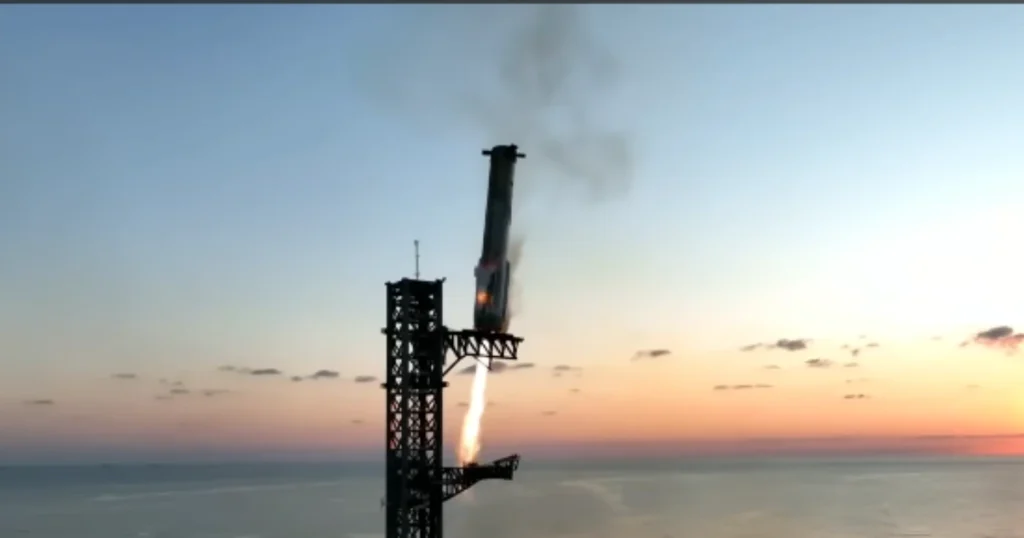
“SpaceX’s successful catch of the Super Heavy booster proves that complex rocket recovery systems can work effectively.”
The successful SpaceX Starship booster catch on October 13, 2024, represents a monumental leap in space exploration technology. This achievement marks the first time in history that a rocket booster has been caught by mechanical arms after completing its mission. The innovation demonstrates SpaceX’s commitment to revolutionizing space travel through reusable technology.
The Historic Flight
On a crisp morning at Boca Chica Star-base, the SpaceX Starship Flight 5 took off at 8:25 a. m. Eastern. The primary goal of this test was for SpaceX to recover the Super Heavy booster. The plan involved having the booster return to the launch site, where it would be caught by two mechanical arms, often referred to as “chopsticks,” attached to the launch tower from which it had lifted off. Achieving this required the booster to execute precise boost-back and landing burns to navigate back to the launch pad successfully.
Successful Catch of Booster 12
The Super Heavy booster, designated as Booster 12, successfully accomplished this task approximately seven minutes after liftoff. The booster descended over the launch pad. The two mechanical arms, affectionately nicknamed “Mechazilla catch,” then closed around the top of the booster, just below its grid fins, effectively achieving the desired catch.
This successful recovery is vital for SpaceX’s long-term plans for rapid re-flight of their vehicles. However, the company envisions that a landed booster could be quickly prepared for its next mission, potentially within days or even hours.
Thus, the spacecraft reusability concept has moved from theory to reality with this achievement. SpaceX’s successful catch of the Super Heavy booster proves that complex rocket recovery systems can work effectively. This development sets a new standard for the entire space industry innovation sector. Watch SpaceX Catch A Starship Booster In Air
The Significance of the Super Heavy Booster in SpaceX’s Mission
The Super Heavy booster serves as the powerhouse of the SpaceX Starship system. This massive first stage generates millions of pounds of thrust through its Raptor engine array. The booster’s successful recovery represents a crucial step toward achieving fully reusable space transportation.
Engineers designed the booster with precise specifications to enable both powerful launches and controlled descents. The integration of grid fins and sophisticated control systems allows for accurate positioning during the critical SpaceX Starship booster catch maneuver. These technical achievements support Elon Musk SpaceX’s broader vision of regular Mars missions.
Overview of Starship Flight 5: A Historic Launch
The mission demonstrated multiple technological advances, including improved flight controls and enhanced communications systems. The launch proceeded flawlessly, setting the stage for the historic booster recovery attempt.
The flight plan included several critical phases. After main engine cut-off, the Super Heavy booster separated from the upper stage. The booster then executed a complex series of maneuvers to position itself for the unprecedented SpaceX Starship booster catch attempt.
Understanding the Mechazilla Catch System
The Mechazilla catch system represents a breakthrough in launch vehicle recovery technology. This innovative system consists of two massive arms mounted on the launch tower. Engineers designed these arms to safely catch and stabilize the returning booster.
The system’s sophisticated sensors and control mechanisms enable precise tracking of the descending booster. Real-time adjustments account for wind conditions and other environmental factors. This technology proves essential for the success of the SpaceX Starship booster catch maneuver.
How Robotic Arms Revolutionize Rocket Recovery
The robotic arms landing system transforms traditional rocket recovery methods. Previous recovery techniques required large landing pads or ocean platforms. The new system minimizes recovery infrastructure while maximizing efficiency.
These arms operate with unprecedented precision. Their movement synchronizes perfectly with the descending booster, ensuring a safe catch. Hence, this innovation advances spacecraft development significantly, potentially reducing turnaround time between launches to hours instead of days.
The Role of Boca Chica Starbase in SpaceX Operations
Boca Chica Starbase serves as the primary development and testing facility for the SpaceX Starship program. The facility features advanced manufacturing capabilities, testing areas, and the revolutionary launch tower equipped with the SpaceX Starship booster catch system.
SpaceX continues to expand the facility’s capabilities. New infrastructure supports increased launch frequency and improved recovery operations. The success at Boca Chica provides valuable experience for future operations at Cape Canaveral and other launch sites.
Technical Details of the Super Heavy Booster’s Descent
The Super Heavy booster descent involves complex aerodynamic maneuvers. The booster first performs a boost-back burn to reverse its horizontal velocity. It then executes a precise entry burn to protect itself from atmospheric heating. These maneuvers require perfect timing and coordination.
The final phase of the SpaceX Starship booster catch demands extreme precision. Multiple Raptor engines fire at carefully calculated intervals to control the descent speed. The booster’s grid fins provide aerodynamic stability throughout the entire process, enabling accurate positioning for the catch.
The Importance of Precision in Booster Landing
Bill Gerstenmaier, vice president of build and flight reliability, highlighted the remarkable precision achieved during testing. The team demonstrated half-centimeter accuracy in ocean landing tests before attempting the tower catch.
This level of precision proves essential for successful SpaceX Starship booster catch operations. Before the launch, he said on Oct 9th, meeting of the National Academies’ Committee on Biological and Physical Sciences in Space,
“We landed with half a centimeter accuracy in the ocean”
Bill Gerstenmaier
He further added:
“so we think we have a reasonable chance to go back to the tower.”
The landing system processes data from multiple sensors in real-time. Wind speeds, atmospheric conditions, and booster telemetry feed into sophisticated control algorithms. This precision enables safe recovery of the massive rocket booster, advancing spacecraft reusability goals.
Analyzing the Indian Ocean Splashdown: Success and Challenges
The Starship upper stage executed a successful mission with a controlled splashdown in the Indian Ocean, marking a significant milestone for SpaceX. This phase of the flight was crucial for testing key systems that are essential for future orbital missions. The successful splashdown not only validates SpaceX’s approach to spacecraft development but also provides valuable insights for upcoming flights.
Technical Achievements During Splashdown
During its descent, the Starship upper stage gathered critical data regarding its performance. Engineers closely monitored various parameters, including heat shield integrity and aerodynamic behavior during reentry.
Since, these enhancements aimed to mitigate damage during reentry, ensuring the spacecraft could withstand extreme temperatures and pressures. The controlled splashdown occurred approximately 66 minutes after liftoff. The upper stage reached a peak altitude of nearly 90 miles before reentering Earth’s atmosphere.
As it descended, onboard cameras captured a smooth transition through the atmosphere, showcasing a pinkish-purple plasma envelope covering the ship’s surface. This visual confirmed that the vehicle was maintaining structural integrity during reentry.
Data Collection and Future Improvements
Engineers collected invaluable data throughout this process. This information will be instrumental in enhancing future flights and developing full reusability capabilities for SpaceX vehicles. The data gathered will inform adjustments to design and operational procedures, ultimately leading to more reliable missions.
The chosen splashdown location in the Indian Ocean provided optimal conditions for testing while ensuring public safety. The vast area on water minimizes risks associated with potential debris falling onto populated areas. Moreover, this strategic choice allows for easier recovery operations if needed in future tests.
Heat Shield Tiles: Protecting Starship During Reentry
The vehicle was equipped with 18,000 heat shield tiles. The improved tiles demonstrated superior performance during Flight 5. Engineers enhanced the thermal protection system based on data from previous flights. These improvements protect the vehicle during the intense heat of atmospheric reentry.
The success of the heat shield system brings SpaceX closer to achieving rapid reusability. Each flight provides new data about tile performance and durability. This information drives continuous improvements in thermal protection technology.
The FAA Launch License: Navigating Regulations for SpaceX
The FAA launch license approval process required extensive documentation and safety analysis. SpaceX worked closely with regulators to address all safety and environmental concerns. The last-minute license approval demonstrated the complex balance between innovation and regulatory compliance.
The environmental assessment covered multiple aspects of launch operations. These included noise impacts, wildlife protection, and debris management. The successful completion of this process establishes important precedents for future SpaceX Starship booster catch operations.
Insights from Gwynne Shotwell on SpaceX’s Achievements
Gwynne Shotwell, SpaceX’s President, expressed amazement at the successful catch. Her reaction highlighted the groundbreaking nature of this achievement. She emphasized how this success advances SpaceX’s goals for frequent, reliable space access.
Shotwell’s leadership continues to drive innovation in space transportation. Her focus on practical solutions and operational efficiency shapes SpaceX’s approach to spacecraft development. The successful booster catch validates her team’s dedication to pushing technological boundaries.
Bill Gerstenmaier’s Perspective on Spacecraft Reliability
Bill Gerstenmaier brings decades of aerospace experience to his analysis of the SpaceX Starship booster catch system. His expertise helped guide the development of reliable recovery procedures. His confidence in the system stems from extensive testing and careful engineering analysis.
Gerstenmaier emphasizes the importance of systematic testing and verification. His approach ensures that each new capability builds upon proven foundations. This methodology supports SpaceX’s rapid development while maintaining high safety standards.
The successful implementation of the catch system validates Gerstenmaier’s methodical approach to spacecraft development. His insights continue to influence SpaceX’s testing and operational procedures. This careful balance of innovation and reliability drives the company’s success in advancing space technology.
SpaceX Starship Booster Catch: Future Implications and Development Plans
NASA’s Lunar Lander Program and Its Connection to Starship
The NASA lunar lander program maintains strong ties to SpaceX Starship development. The successful SpaceX Starship booster catch provides crucial validation for NASA’s decision to select Starship as their lunar landing system. This achievement demonstrates the reliability and innovation necessary for lunar missions.
The Starship propellant transfer capability remains essential for lunar operations. NASA estimates approximately 16 fuel transfers will support each lunar mission. The ability to catch and rapidly reuse boosters enables the frequent launches needed for these orbital refueling operations.
The Future of Spacecraft Reusability with SpaceX Starship
The SpaceX Starship booster catch system revolutionizes spacecraft reusability. Traditional rocket recovery methods require extensive refurbishment periods. The new system promises rapid turnaround times, potentially enabling multiple launches per day from the same booster.
Space transportation costs could decrease dramatically through this innovation. Elon Musk’s SpaceX projects launch costs might drop to $2-3 million per flight. This reduction transforms the economics of space access, enabling new commercial opportunities and scientific missions.
Environmental Assessments and Their Impact on Launches
The comprehensive environmental assessment process addresses multiple concerns at Boca Chica Starbase. Regulators examine noise impacts, wildlife protection measures, and debris management strategies. These assessments ensure responsible development of space technology.
SpaceX implements various mitigation strategies to protect local ecosystems. The water deluge system underwent careful review to prevent environmental damage. Regular monitoring programs track and minimize the environmental impact of launch operations.
Cape Canaveral: A New Launch Site for SpaceX Missions
Cape Canaveral expansion plans demonstrate SpaceX’s commitment to increased launch capacity. The company develops new infrastructure to support SpaceX Starship booster catch operations at this historic launch site. This expansion enables more frequent launches while maintaining operational flexibility.
Furthermore, the facility will complement Boca Chica Starbase operations. Engineers design the new launch tower with improved robotic arms landing capabilities. These enhancements incorporate lessons learned from Texas operations.
The Evolution of the Raptor Engine and Its Importance
The Raptor engine continues to evolve with significant performance improvements. Engineers increase thrust capabilities from 230 to potentially over 330 metric tons-force. These advancements support more ambitious missions and larger payload capacities.
Enhanced engine performance enables successful SpaceX Starship booster catch maneuvers. The precise control provided by improved Raptor engines allows exact positioning during descent. This capability proves crucial for safe booster recovery operations.
Future Plans for Starship-II and Starship-III Development
Starship-II Enhancements
Propulsion System Updates
The SpaceX Starship booster catch system receives major upgrades in Starship-II. Engineers implement new Raptor engines with 20% more thrust. The increased power enables better control during landing sequences. These modifications help perfect the SpaceX Starship booster catch mechanism.
Fuel System Improvements
Starship-II features redesigned propellant tanks. The tanks hold 30% more fuel than the original version. This additional capacity extends flight duration significantly. Moreover, the new tank design reduces fuel loss during long-duration missions.
Landing System Refinements
The SpaceX Starship booster catch system undergrades extensive testing for Starship-II. New mechanical arms provide more precise control. Advanced sensors improve timing accuracy. These changes increase the success rate of booster recovery operations.
Starship-III Innovations
Size and Scale
Starship-III grows 25 meters taller than Starship-II. This increased height adds substantial internal volume. The larger size accommodates bigger payloads. Furthermore, the new dimensions support enhanced crew quarters.
Payload Capacity
The SpaceX Starship booster catch system adapts to handle heavier loads. Starship-III carries over 200 metric tons in reusable mode. This capacity doubles current capabilities. The improved strength supports more diverse mission types.
Advanced Materials
Engineers select new composite materials for Starship-III. These materials reduce overall weight. They also provide better thermal protection. Additionally, the materials enhance the durability of critical components.
Mission Capabilities
Starship-III supports extended space exploration missions. The vehicle enables longer stays in orbit. It accommodates larger crew sizes. Subsequently, the design allows for more scientific equipment.
Ground Infrastructure
New launch facilities support Starship-III operations. The SpaceX Starship booster catch system receives structural reinforcements. Engineers build larger fuel storage systems. These improvements enable faster launch frequencies.
Safety Features
Starship-III includes redundant safety systems. Emergency abort capabilities improve significantly. Multiple backup systems protect crew members. Therefore, the vehicle meets stricter safety standards.
Both iterations represent major steps in spacecraft development. Each version builds upon previous successes. These improvements push space exploration forward. The SpaceX Starship booster catch system remains central to these advancements.
Space Exploration Goals: Mars Missions and Beyond
The successful SpaceX Starship booster catch supports long-term Mars mission objectives.
“Reliable booster recovery enables frequent launches necessary for Mars colonization. SpaceX plans regular cargo missions to support future human presence on Mars.”
Beyond Mars, the system opens possibilities for deeper space exploration. The improved economics of launch operations enables more ambitious scientific missions. These capabilities support human expansion throughout the solar system, advancing Elon Musk SpaceX’s vision of multiplanetary civilization.
SpaceX continues developing technologies for long-duration spaceflight. Improved life support systems and radiation protection advance human spaceflight capabilities. These developments support both Mars mission goals and broader space exploration objectives.
Economic and Strategic Implications of SpaceX’s Booster Recovery Innovation
Economic Benefits of Launch Vehicle Recovery Techniques
The successful SpaceX Starship booster catch system transforms space launch economics. Traditional expendable rockets cost hundreds of millions per launch.
“The new recovery system reduces these costs dramatically, potentially reaching $2-3 million per launch. This cost reduction opens new opportunities for commercial space activities.”
The rapid reusability enabled by the robotic arms landing system increases launch frequency. Companies can now plan multiple missions without waiting for new rocket production. This efficiency creates new business models in satellite deployment, space manufacturing and scientific research.
Spacecraft reusability also reduces environmental impact and material waste. The ability to reuse complex rocket components saves valuable resources. This sustainability aspect provides both economic and environmental benefits for the space industry.
Merits and Demerits of the Booster Catch Approach
The SpaceX Starship booster catch system offers several advantages. The precision landing eliminates the need for large landing pads or ocean platforms. The immediate capture enables rapid inspection and re-flight preparation. These benefits support SpaceX’s goals for high-frequency launches.
However, the system faces certain limitations. Weather sensitivity can restrict operations. The complex mechanical systems require careful maintenance. The catch mechanism adds structural requirements to the launch tower design.
The technology proves most beneficial at established launch sites like Boca Chica Starbase and Cape Canaveral. The infrastructure investment limits deployment to major launch facilities. Yet the operational benefits outweigh these limitations for high-frequency launch operations.
Risks Involved in the SpaceX Booster Recovery Process
The SpaceX Starship booster catch process involves significant technical risks. The precise coordination required between the booster and robotic arms leaves little margin for error. Environmental factors such as wind conditions can complicate the catch attempt.
Structural risks exist for both the booster and tower. The momentum of the massive rocket requires careful management during the catch. System failures could damage expensive equipment or delay launch operations.
Safety considerations extend beyond the immediate catch area. The return trajectory must avoid populated areas. Backup systems ensure safe operation even if the primary catch mechanism fails.
Elon Musk’s Vision for Interplanetary Travel with Starship
Elon Musk SpaceX maintains ambitious goals for human space exploration. The SpaceX Starship booster catch system supports regular Mars mission operations. This capability enables frequent cargo launches necessary for establishing a permanent Mars presence.
The development of Starship-II and Starship-III demonstrates long-term commitment to interplanetary travel. These vehicles provide increased payload capacity and improved efficiency. Such capabilities support both lunar missions and Mars colonization efforts.
The space transportation system’s reliability advances human space exploration goals. Regular launches support orbital refueling operations needed for deep space missions. This infrastructure enables sustained human presence beyond Earth orbit.
Conclusion: The Ultimate Benefits of SpaceX’s Innovations for Humanity
The successful SpaceX Starship booster catch represents more than technical achievement. This innovation opens new possibilities for scientific research, commercial development and human exploration. The reduced launch costs enable broader participation in space activities.
The advancement of space technology through these innovations benefits multiple sectors. Medical research in microgravity becomes more accessible. New manufacturing processes in space create unique materials. Educational opportunities expand through increased space access.
The long-term impact extends to human civilization’s future. Regular access to space supports resource exploration beyond Earth. The potential for human settlement on other worlds becomes more realistic. SpaceX’s achievements in spacecraft development set up a foundation for humanity’s expansion into the solar system.
Check out another good read on Nova Explosions: Exploring 8 Intriguing Factors Behind it
Citations
- https://www.reuters.com/technology/spacex-catches-starship-booster-historic-test-flight-2024-10-13/
- https://www.bbc.com/news/science-environment–67012345
- https://www.space.com/spacex-starship-booster-catch-success
- https://www.theguardian.com/science/2024/oct/13/spacex-starship-rocket-test-flight-elon-musk
- https://www.nasaspaceflight.com/2024/10/starship-flight-5/
- https://spaceflightnow.com/2024/10/13/spacex-launches-fifth-starship-test-flight-catches-booster/
- https://arstechnica.com/science/2024/10/spacex-achieves-historic-catch-of-starship-booster/
- https://www.cnbc.com/2024/10/13/spacex-starship-flight-5-launch-booster-catch.html
- https://www.teslarati.com/spacex-starship-booster-catch-success/
- https://www.inverse.com/science/spacex-starship-booster-catch
- https://www.engadget.com/spacex-successfully-catches-starship-booster-with-robotic-arms-184523715.html
- https://www.sciencealert.com/spacex-just-caught-its-massive-starship-booster-for-the-first-time
- https://www.popularmechanics.com/space/rockets/a45431298/spacex-starship-booster-catch/
- https://www.universetoday.com/161234/spacex-catches-starship-booster-in-historic-first/
- https://www.businessinsider.com/spacex-starship-booster-catch-robotic-arms-elon-musk-2024-10



Leave a Reply